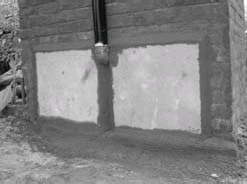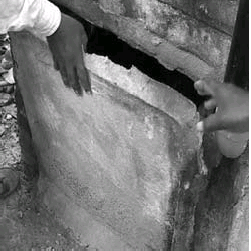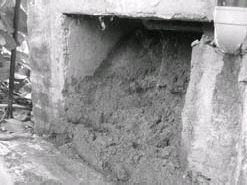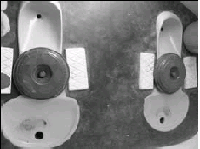<<< Previous
|
|
Next
> >>
|
| How does it work? |
j   |
 The toilet
is designed in such a way that the Urine is seperated from the faeces.
Further the water used for washing of hands as well as the toilet is
seperated out and sent to natural filter beds, from where it irrigates a
field nearby. The urine is taken by a separate pipe and stored in a vessel
to be used as fertiliser. The faecus is kept dry by adding ash and lime, so
the time taken to destroy the pathogens is shorter.When the first chamber is
full it is sealed up, and the time taken for the next chambers to get filled
up is sufficient for the excreta to degrade so that it can be handled
safely, without odour, and is ready to use as manure.
The toilet
is designed in such a way that the Urine is seperated from the faeces.
Further the water used for washing of hands as well as the toilet is
seperated out and sent to natural filter beds, from where it irrigates a
field nearby. The urine is taken by a separate pipe and stored in a vessel
to be used as fertiliser. The faecus is kept dry by adding ash and lime, so
the time taken to destroy the pathogens is shorter.When the first chamber is
full it is sealed up, and the time taken for the next chambers to get filled
up is sufficient for the excreta to degrade so that it can be handled
safely, without odour, and is ready to use as manure.Benefits of ECOSAN toilets
- Prevent ground water contamination as the chambers are kept above ground and full sealed. Ideal for users in water logged, high ground water table areas.
- The unit does not require any type of flushing mechanism, eliminating the risk of mechanical failure. Does not require de-sludging or pumping out black water
- It has no sewer connections. Saves water as it does not require any water to carry humanwaste; no plumbing is required.
- Does not require any treatment of urine or faeces.
- No flies or foul smell.Nomosquito breeding as there is nowater stagnation.
Factors influencing design andmanagement of Ecosan toilets
d
d
Population density, settlement pattern: -the availability of space for on-site/off-site processing, storage and local recycling.
d
d
Economic: -the financial
resources of both individuals and the community as awhole to support the
ecosan systemd
Technical Capacity: -the level
of technology that can be supported and maintained by local skills and toolsd
Institutional Support: - legal
framework, extent of support for the eco-san concept in government,
industry, financial institutions, universities and NGOs. "A Guide to Sanitation and
Hygiene for Those Working in Developing Countries"
- Sari Huuhtanen and Ari Laukkanen - Ecological sanitation systems can make an invaluable contribution to sustainable livelihoods and poverty reduction, including in urban areas, by increasing food security through the return of nutrients from excreta to the soil to increase soil fertility and by reducing pollution and health risks. Such systems also impact positively on food security through better management of scarce water resources and contribute to health through reducing transmission of disease and increasing nutritional intake (ibid). The compost produced can be sold or used ifor household food production. The establishment of home gardens and sale of produce can be facilitated and the resulting increased income can lead to greater nutritional well-being for families. The establishment of an ecological sanitation system can create opportunities for local entrepreneurs to design and build toilets as well as provide training on the building of the toilets and the use of the end product, creating further income generation potential. |
|
Applicability of Ecosan
Most NGOs agree that Ecosan is a very good design. But the most important problem is to convince people. It is also very difficult for people who have used flush type of toilets to accept dry compost type of toilets. They also need to make that extra effort to do the job such that they urinate in the proper place and drop their faecus directly into the hole.
And then to cover the crop hole, and shift slightly to wash themselves. . It is important to make the people culturally, socially comfortable using Ecosan type of toilets. There is need for regular monitoring and followup
Thus many NGOs are concentrating on developing improved versions of pit latrines at the individual level. Since correct use of water, namely complete separation of urine and water from faeces, will probably take time and practice, some NGOs have suggested the adaptation of a decentralised water management systems (DEWAMS). The design for this system calledDEWATS is taken up more fully in the next chapter.
<<< Previous
|
|
Next
> >>
|